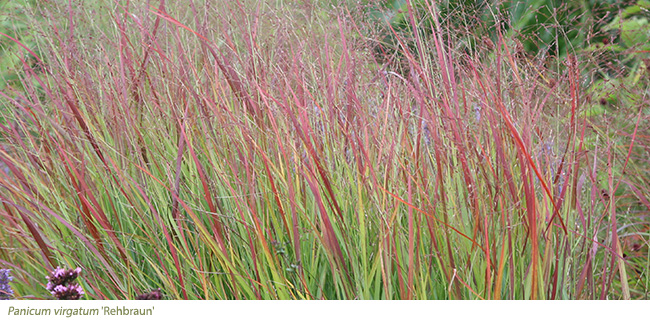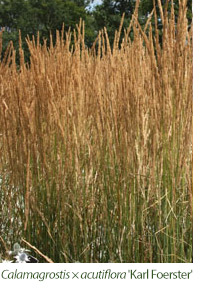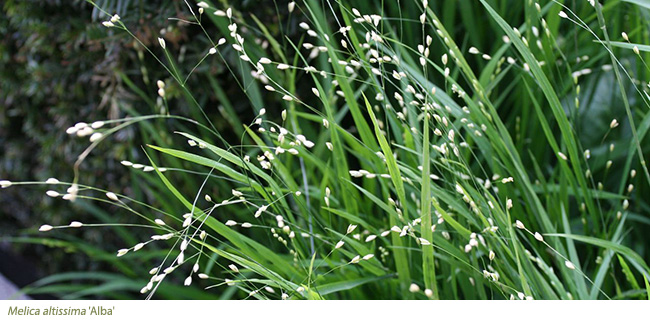
Late-season grasses come into their own from September adding another element or two - movement and texture to your garden. Most are tall and graceful and most move and sway with a gossamer presence. As autumn continues the texture of the awns, be it soft and fluffy or shiny and beaded, gets even more pronounced adding texture and form that lasts into winter.
Stance varies between a rocket-like stand of upright fine stems, to graceful long-stemmed feathers that fan outwards and upwards, to a curtseying sheath that nudges over the front of the border or lawn.
Many grasses grow at the edge of their range here, so in colder parts of Britain they will flower much later than they do in the south. This may influence your choice.
Grasses have been used since the Victorian times by designers such as Gertrude Jekyll and William Robinson. However the craze for grasses really took hold in Germany. Their use was pioneered by a German landscape architect and nurseryman called Karl Foerster, -he referred to grasses as nature’s hair and popularised them.
William Robinson championed wild gardening and grasses, an antidote to colourful and ordered bedding schemes so beloved by his fellow Victorians. He’s thought to have been the first man to grow Pampas grass (Cortaderia selloana) in England, having planted it in Regent’s Park in London after seeing it at the National Botanic Gardens at Glasnevin near Dublin as a young gardener. These can be enormously tall, but Cortaderia selloana ‘Pumila' is a compact form rising to five or six feet only. The plumes appear in autumn and last through winter, forming exclamation marks in the border.
 Molinias are very different, because they have a ruff of foliage at the base and long stems topped in heads that vary enormously from the fine beads of ‘Transparent’ to the more substantial heads of ‘Windspiel’ (literally wind’s game). These elegant grasses shimmy and shake and they make a wonderful veil towards the front of the border. Molinia caerulea subsp. caerulea ‘Heidebraut' (heather bride) is valued for it’s see-through stems and golden autumn colour.
Molinias are very different, because they have a ruff of foliage at the base and long stems topped in heads that vary enormously from the fine beads of ‘Transparent’ to the more substantial heads of ‘Windspiel’ (literally wind’s game). These elegant grasses shimmy and shake and they make a wonderful veil towards the front of the border. Molinia caerulea subsp. caerulea ‘Heidebraut' (heather bride) is valued for it’s see-through stems and golden autumn colour.
American Switch grass, Panicum virgatum, needs warmth to flower well, so it’s not for colder gardens. If it does well for you, the Panic grass (named because the heads shake at the slightest movement), also needs good drainage. Foliage varies from the grey-leaved sheath of ‘Heavy Metal’ to the redder foliage of ‘Shenandoah’. The most attractive is ‘Rehbraun' which has green foliage topped by purple and green spikelets.

Pennisetums love a well-drained hot spot too, but there are cold-tolerant varieties on offer such as P. alopecuroides ‘Hameln’ that still provide pale green caterpillars. P. villosum, which produces a short stubby caterpillar with a fluffed-up presence, will come through winter in well-drained gardens. However treating it as an annual in colder, wetter gardens is an option because few grasses curtsey as attractively or look so good in sunny position.
Calamagrostis bracytricha, the Korean feather reed grass, is an option for shade, with heather-pink, knee-high, silky awns that appear in late-August or September. Regular division every four or so years is needed to keep it vigorous, and this is done in spring, the best time to tackle dividing grasses.
 Calamagrostis x acutiflora ‘Karl Foerster’ must be the world’s best architectural grass because the green foliage and dark awns, which appear in mid-June normally, age to a ramrod straight sheath of russet and gold. No other grass provides the same vertical presence and it forms the basis of many a prairie-style Piet Oudolf inspired border. It’s sterile, forms a tight clump and by September the awns begin to resemble narrow tapers.
Calamagrostis x acutiflora ‘Karl Foerster’ must be the world’s best architectural grass because the green foliage and dark awns, which appear in mid-June normally, age to a ramrod straight sheath of russet and gold. No other grass provides the same vertical presence and it forms the basis of many a prairie-style Piet Oudolf inspired border. It’s sterile, forms a tight clump and by September the awns begin to resemble narrow tapers.
At the other end of the scale there’s the graceful Hakon grass (Hakonechloa) which flows over the edges like water so it can be used in containers, or close to steps, or in borders that retain moisture, or to soften a hard edge. It disappears underground in winter, although it’s very hardy, and reappears in spring. There are golden forms of Hakonechloa macra, such as ‘All Gold’ and garishly variegated ones such as ‘Alboaurea' and a cooler green and white named ‘Albovariegata' and they’re all good in shade as long as the soil stays moist.

If you’ve a wild garden, or a William Robinson streak for nature, a form of our native wood millet, Melica altissima ‘Alba’, is the prettiest thing among ferns in shade. The white beads of the flowers, no larger than a grain of rice, tremble and shake as daintily as a ballerina on points. Quite beguiling and completely different from any other grass.




 Molinias
Molinias
 Calamagrostis x acutiflora ‘Karl Foerster’
Calamagrostis x acutiflora ‘Karl Foerster’
